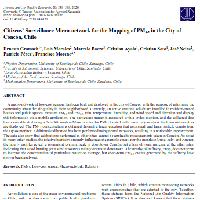Resumen
- A micro-network of low-cost sensors has been built and deployed in the city of Concon with the purpose of informing the community about the air quality in their neighborhood. Currently, 10 active stations, which are installed in resident-owned houses and public spaces, measure PM10 and PM2.5, rain, temperature, humidity, and wind speed and direction and display this information via a mobile application. The particulate matter is measured with a Dylos monitor, and the collected data has been calibrated using a Beta Attenuation Mass monitor for PM2.5 located in the same city as where the low-cost monitors are deployed. The PM2.5 concentration is obtained through a linear equation that uses small and large particle counts from the Dylos monitor. Additional calibration has been performed using neural networks, resulting in a noticeable improvement. The data also show that calibrations performed in other cities cannot be applied to measurements taken in Concon. As noted in many other studies, the relative humidity strongly influences the particle count. For the months of June, July, and August, the hourly profiles reveal a prominent evening peak in downtown Concon but a less obvious increase at the other sites, indicating that wood burning (or a similar source) mainly occurs in downtown. The nearby oil refinery, Enap, does not seem to increase the concentration of particulate matter on average, but short-term PM2.5 events generated by the refinery have not yet been analyzed.
